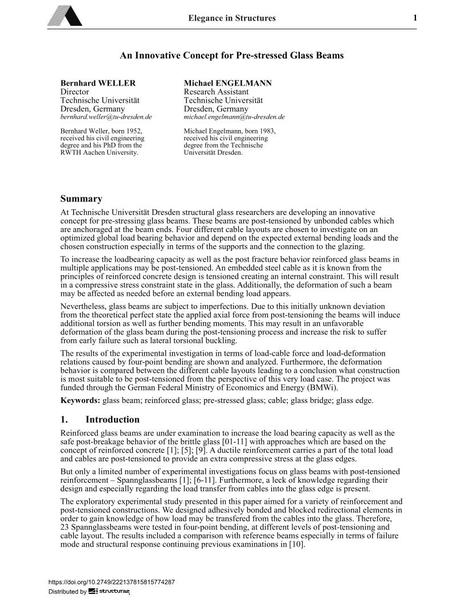An Innovative Concept for Pre-stressed Glass Beams

|
|
|||||||||||
Bibliographic Details
| Author(s): |
Bernhard Weller
Michael Engelmann |
||||
|---|---|---|---|---|---|
| Medium: | conference paper | ||||
| Language(s): | English | ||||
| Conference: | IABSE Conference: Elegance in structures, Nara, Japan, 13-15 May 2015 | ||||
| Published in: | IABSE Conference Nara 2015 | ||||
|
|||||
| Page(s): | 132-133 | ||||
| Total no. of pages: | 8 | ||||
| Year: | 2015 | ||||
| DOI: | 10.2749/222137815815774287 | ||||
| Abstract: |
At Technische Universität Dresden structural glass researchers are developing an innovative concept for pre-stressing glass beams. These beams are post-tensioned by unbonded cables which are anchoraged at the beam ends. Four different cable layouts are chosen to investigate on an optimized global load bearing behavior and depend on the expected external bending loads and the chosen construction especially in terms of the supports and the connection to the glazing. To increase the loadbearing capacity as well as the post fracture behavior reinforced glass beams in multiple applications may be post-tensioned. An embedded steel cable as it is known from the principles of reinforced concrete design is tensioned creating an internal constraint. This will result in a compressive stress constraint state in the glass. Additionally, the deformation of such a beam may be affected as needed before an external bending load appears. Nevertheless, glass beams are subject to imperfections. Due to this initially unknown deviation from the theoretical perfect state the applied axial force from post-tensioning the beams will induce additional torsion as well as further bending moments. This may result in an unfavorable deformation of the glass beam during the post-tensioning process and increase the risk to suffer from early failure such as lateral torsional buckling. The results of the experimental investigation in terms of load-cable force and load-deformation relations caused by four-point bending are shown and analyzed. Furthermore, the deformation behavior is compared between the different cable layouts leading to a conclusion what construction is most suitable to be post-tensioned from the perspective of this very load case. The project was funded through the German Federal Ministry of Economics and Energy (BMWi). |
||||
| Keywords: |
cable glass beam glass edge reinforced glass pre-stressed glass glass bridge
|
||||
